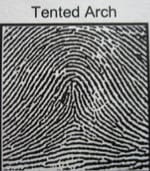FINGERPRINTS :AN OVERVIEW
Written by: Devika
- Fingerprints are the impression made by the papillary ridges on the ends of the fingers and thumbs.
- Fingerprints leaves imprints which are made up of water (98-99%), oils and salts.
- Fingerprints are formed at 10 weeks in womb during gestation.
- They were used as a means of identification because the ridge arrangement on every finger of every human is unique and persistent throughout life.
- Sir Francis Galton’s is often referred to as Father of Fingerprint.
- Study of fingerprints is called Dactyloscopy, pioneered by Juan Vucetich in 1891.
- The size of an average fingerprint is about 0.5”-0.7”(smaller for children and females, larger for adult males).
FINGERPRINT- AN IDENTIFICATION TOOL
- Fingerprint as evidence plays a major role because of the following features,
- Unique- Fingerprints are the impression made by papillary ridge, which is unique with in an individual.
- Permanent- Fingerprints are permanent and persistent throughout lifetime. The friction ridges are formed at third month of gestation. Even the fingerprints remain after death of an individual until epidermis layer destroyed by fire, insects or putrefaction. Fingerprints can’t be altered through surgery.
- Universal- Fingerprints are of universal nature which means all individuals carry this medium of identification.
- Inimitable- Imitation of fingerprints cannot be happen because it is the impression made by papillary ridges.
- Classifiable- Classification of fingerprints can be done easily because everyone has different fingerprint pattern and it is unique also.
TYPES OF FINGERPRINTS
There are 3 types of fingerprints
- Latent fingerprint
- Patent fingerprint
- Plastic fingerprint
Latent fingerprints
- Latent fingerprints are made of sweat are made of sweat and oil on the skins surface.
- It is invisible to the naked eye and require additional developments in order to be seen
- It can be developed by using powder techniques or using chemical methods.
- It is the best print; it can be used for personal identification.
Plastic fingerprints
- Fingerprints that have been pressed, moulded or shaped into soft material such as dirt, mud, or clay, soap or wax.
- Also known as Impressions because 3D replica of body part.
- Plastic prints are visible to the naked eye and can be easily found without any development such as fingerprint dusters, lights and powders or scanners.
Patent fingerprints
- Also known as Visible fingerprints.
- Fingerprints left behind when an individual has some form of liquid (or powder) on their fingers.
- The most common types of liquids associated with visible fingerprints include blood, ink, grease and dirt.
- When an individual touches another surface such as glass or wall, the liquid on the ridges of their finger is transferred to create as lasting image.
- Patent fingerprints are easily visible to naked eye and no need of any developmental technique.
CLASSIFICATION OF FINGERPRINT
According to Galton, mainly 3 types of patterns:
- Loop-Those patterns tend to curve back upon themselves.
- Whorls-Those pattern tends to be circular.
- Arches-Those patterns which form no loops or circles.
Arches
- Only 5% of fingerprint patterns are arches.
- No core or no delta, no type line.
- Simplest pattern.
- In arches, the ridges of the finger run continuous from one side of the finger to the other with no recurving.
- Arches have 2 subgroups:
- Plain arch-Usually a type of fingerprint pattern in which ridges enter up on one side and make a wave in centre and flow out upon the opposite side.
- Tented arch- Type of pattern which posses an upthrust that is like similar of the characteristics of a loop pattern.
Loop
- 60-65% of fingerprint patterns are loop.
- Common fingerprint pattern.
- One delta and one core.
- Loop must have 1 or more ridges entering from one side of the print, recurring and existing from the same side.
Two subgroups:
- Radial loop-It is a type of loop pattern in which slanting or looping ridge flow towards the thumb finger.
- Ulnar loop-It is a type of loop pattern in which slanting ridge flows towards the little thumb or little finger.
Whorls
- 35% of fingerprint patterns are whorl.
- Basic requirements: - Two or more delta, at least one completing circulating ridge.
- Three subgroups:
- Plain whorl-possesses type lines and at least two deltas. At least one ridge that makes a complete trip, ridge maybe in the form of spiral, oval, circle or variant circle. Most common form of whorl and mostly found.
- Central pocket loop- In these whorls, one or more of the simple recurves of the plain whorl recurves a second time.
- Double loop-It is made up of two loops joint into one fingerprint.
FORENSIC SIGNIFICANCE
- It helps investigators to link one crime scene to another involving the same person .
- Fingerprints also used to track a criminals record so that their history of crime or proceeding can be found easily.














0 Comments